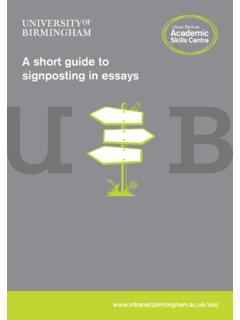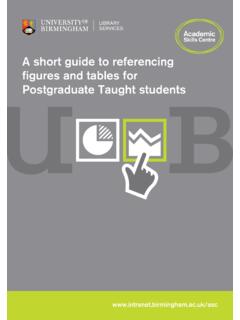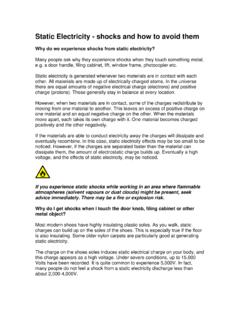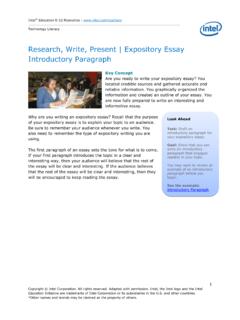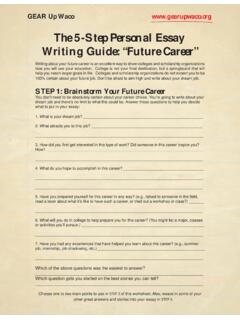Transcription of A short guide to essay planning and structure - Intranet home
1 112A A short guide to essayplanning and structure2A short guide to essay planning and structureThe importance of planning and structuringThe purpose of an essay is to present a logical, reasoned argument in response to a specific question. An effective structure helps your argument to unfold clearly to the reader. You want your response to be focussed and progressive, rather than just a jumble of ideas. This guide suggests some ways of planning and structuring your essays . The process of essay planningEverybody works in a different way, so you need to find a planning and writing process that suits you. However, it is important not to leap too quickly from research to writing. It is worth giving some thought to how you will order your ideas, and what the central argument of your essay will the next page you will find a suggested process for planning an essay .
2 You may wish to reflect on your own process and consider whether it is working. Have you had any feedback from your tutors about poor structure or lack of a focussed argument? If so, do you need to spend more time thinking about the thread that will run through your essay ? A few questions to ask yourself when planning your essay Do I understand what my assignment question is asking? What is my instinctive response to the question? What do I already know that is of relevance to the question? What else do I need to find out? What have other scholars written on this topic and do I agree/disagree with them? What is the main point I want to argue or put across in this essay ? What reasons do I have to support my main argument or message? (ie, why should my reader believe me?)
3 Now decide on a logical order for your points. You could summarise each point on a separate card or sticky note and physically move them around until you have found the best flow. You will find your own method, but the key thing is to be aware of the progression of your argument. How does each point link to the one before it and the one after? How will your paragraphs build your argument? Don t forget to guide your reader through, communicating with them at every your research, identify key points that will help you to answer the question. You could pool these together in a mind map, or on a large piece of paper, or typed document. Then you need to start organising the points. Which are related? Which are counter-arguments? Begin to group ideas. You should also decide what the over-arching argument of your essay is going to be, based on the evidence you have gathered and !
4 Be sure to keep track of where you have obtained information from. Engage with what you are reading, asking questions and challenging points of view. Only note things that are relevant to your essay title. You don t need to include everything about the map everything you already know about the topic. Try to identify what your instinctive response to the essay question is. Identify some research questions to guide your stages of essay planningBreak down the different parts of your assignment question. Figure out what the task word means (eg, discuss, argue, describe) and identify specifically what you need to write about. If the question is very broad and general, decide which aspects to focus your answer short guide to essay planning and structure4A short guide to essay planning and structureThe Rule of Three structureIt is important that your essay has a clear introduction, main body and conclusion.
5 Put simply, you should:The actual number of paragraphs in the main body of the text depends on the topic, the discipline, and the number of words you have to write. The crucial feature of the structure is that each paragraph only contains one main idea. SAY ITSAY WHAT YOU HAVE SAIDSAY WHAT YOU ARE GOING TO SAYTOP TIP!First and last sentences of paragraphs are sentences should tell the reader something clear and specific about the point you are about to discuss. Last sentences should make the relevance of the point totally short guide to essay planning and structureYou could use a diagram like this to help you order your ideas. Write each of your main points into a section of the paragraphSecond introductory paragraph if necessaryBody of essay1st main point2nd main point3rd main point4th main point5th main point6th main pointConclusionConcluding paragraphList of referencesDevelop argument point by point.
6 Put forward the reasons that support the argument you declared in your the reasons that support your argument, with no new information. Remind the reader what you have covered and how you have answered the : context and aim of the essay . State your argument. Indicate how you will answer the short guide to essay planning and structureConclusion It is useful to know what you want to argue before you begin to write. State your argument in your introduction, and then spend the rest of the essay presenting the reasons and evidence that make it valid. Give some thought to the order in which you present these: what would be the clearest and most convincing way to sequence your line of reasoning? TOP TIP!Once you have written your first draft, try to sum up the main point of each paragraph in one sentence.
7 Then look at this outline of your essay . Is it logical?Key structuring conventions to be used: Group similar ideas together rather than jumping around. Individual paragraphs should be differentiated typographically ie, by indenting or by allowing additional line spaces between (check whether your school has a preference). Each paragraph should make only one main point. Think of paragraphs as mini- essays . Start with a topic sentence to introduce the main point of the paragraph; explain that point further; provide evidence for the point; interpret/analyse the evidence; then summarise the point and indicate how it links into your overall argument. Each paragraph should link to the next using transition words or phrases such as alternatively; consequently; as a result ; The paragraphs should be placed in a logical and consistent order.
8 Play around with them until you get the best flow. They should feel progressive rather than short guide to essay planning and structureFurther reading and referencesCooper, H. and Shoolbred, M. (2016) Where s your argument? London: , J. (2014) planning your essay . 2nd ed. Basingstoke: Palgrave-MacMillanUniversity of Essex. (2008) How to improve your academic writing. Available from: (Accessed 1 May 2017)University of Leicester. (2012) Writing essays . Available from: (Accessed 30 January 2017)Academic Skills Centre. June Services Edgbaston, Birmingham, B15 2TT, United University of Birmingham 2017. Printed on a recycled grade paper containing 100% post-consumer and printed by
